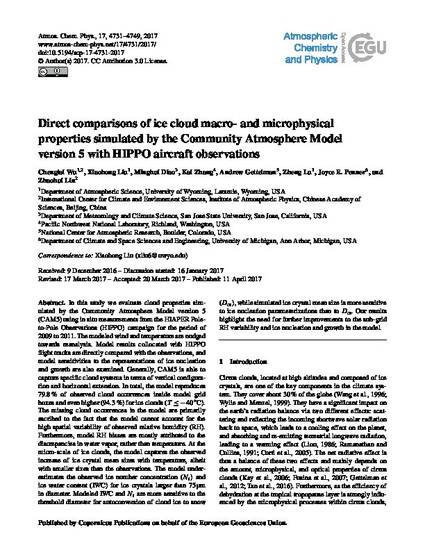
Article
Direct comparisons of ice cloud macro- and microphysical properties simulated by the Community Atmosphere Model version 5 with HIPPO aircraft observations
Atmospheric Chemistry and Physics
(2017)
Abstract
In this study we evaluate cloud properties simulated by the Community Atmosphere Model version 5 (CAM5) using in situ measurements from the HIAPER Pole-to-Pole Observations (HIPPO) campaign for the period of 2009 to 2011. The modeled wind and temperature are nudged towards reanalysis. Model results collocated with HIPPO flight tracks are directly compared with the observations, and model sensitivities to the representations of ice nucleation and growth are also examined. Generally, CAM5 is able to capture specific cloud systems in terms of vertical configuration and horizontal extension. In total, the model reproduces 79.8 % of observed cloud occurrences inside model grid boxes and even higher (94.3 %) for ice clouds (T ≤ −40 °C). The missing cloud occurrences in the model are primarily ascribed to the fact that the model cannot account for the high spatial variability of observed relative humidity (RH). Furthermore, model RH biases are mostly attributed to the discrepancies in water vapor, rather than temperature. At the micro-scale of ice clouds, the model captures the observed increase of ice crystal mean sizes with temperature, albeit with smaller sizes than the observations. The model underestimates the observed ice number concentration (Ni) and ice water content (IWC) for ice crystals larger than 75 µm in diameter. Modeled IWC and Ni are more sensitive to the threshold diameter for autoconversion of cloud ice to snow (Dcs), while simulated ice crystal mean size is more sensitive to ice nucleation parameterizations than to Dcs. Our results highlight the need for further improvements to the sub-grid RH variability and ice nucleation and growth in the model.
Publication Date
April 11, 2017
DOI
10.5194/acp-17-4731-2017
Publisher Statement
This article originally appeared in Atmospheric Chemistry and Physics, 17, 7, 2017. ©2017 Copernicus Publications. This work can also be found online at this link: http://dx.doi.org/10.5194/acp-17-4731-2017
Citation Information
Chenglai Wu, Xiaohong Liu, Minghui Diao, Kai Zhang, et al.. "Direct comparisons of ice cloud macro- and microphysical properties simulated by the Community Atmosphere Model version 5 with HIPPO aircraft observations" Atmospheric Chemistry and Physics Vol. 17 Iss. 7 (2017) p. 4731 - 4749 ISSN: 1680-7316 Available at: http://works.bepress.com/minghui-diao/30/
Creative Commons license

This work is licensed under a Creative Commons CC_BY International License.
